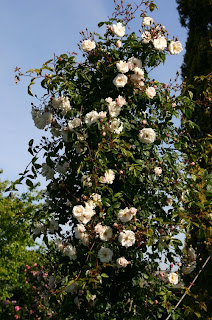The inevitable time is upon us—when growth buds fatten on the bare stems and stretch into little darts, unfurling the first leaves of spring. The Teas and the China roses always have a head start. All they require is a week of sunshine and moderate temperatures, and they're off!
Still pruning? So am I. But now I must turn my attention to the climbers. They aren't growing any faster than the shrub roses, but the manipulation we put them through, unwinding their new long canes and thrashing them about to be repositioned on arbor, wall, arch and pillar, wrecks injury on all that soft new growth. If you haven't tackled them yet, get started now!
In my garden there are 18 rose pillars, six pergolas and two long, 9-foot-high walls of climbing roses, trained on welded wire fencing so that they can be admired from two perspectives in the garden. Soon will be added another 24 pillars and a curved pergola. At our nursery over 100 climbers are trained on 7 foot tall wooden fences, just short enough that they can be managed without the aid of a ladder.
Climbing roses are the apex of art in the rose garden, supassing even tree roses in their demand for careful management. Sure, I sometimes leave the pergolas unpruned, but I've never been pleased for long with the effect that creates. From the tops of the pergolas new canes rise upwards, stretching toward the sun, sometimes creating a bad-hair effect about as silly as a mohawk. Of course these new canes all appear just at the time of first rose bloom, obscuring most of the bloom in their forest of growth. Later in the summer these calm down, arching with their own weight, and if I'm lucky they explode in midsummer with lateral bloom, laden with flowers—a romantic effect to be sure, when it works.
The issue at hand is when to stop pruning, and as you can see, I can't stop quite yet. Once the new foliage unfurls, does it hurt the roses to prune them? Not a whit! The cut ends of canes and branches will quickly heal with the surge of sap in the stems, and new growth will emerger lower down, filling in and softening the effects of pruning before you know it. Teas and Chinas, as I mentioned in an earlier posting, will simply bloom later, and over a longer period of time for their first flowering. This enables me to share the glory of the Teas and Chinas with those who come to visit the garden in May. Left unpruned they will bloom much earlier, often peaking at the end of April. Of course these dates vary by climate, but the basic concept is the same, whether your roses peak in April, May or June.
But, I'll pause now in my pursuit of the Teas and Chinas, to tame the unruly whips and snakes of the climbers in the garden. How lovely a pillar is when it is a pillar and not a whirlygig!
In a few days, I must pause at this critical point in shaping the garden and the roses, with a week-long trip to Bermuda to address the Bermuda Rose Society with three presentations; about the Bermuda mystery roses and how their preservation has changed worldwide attitudes toward old roses, and about found roses and their preservation around the world. I'll also share a bit of my experience and expertise in propagating roses, to help with the Bermudians' efforts to proliferate their roses over the islands. Rumblings of concern have reached me that I may not be able to extricate myself from all the pruning left to do and that I might not show up! Rest assured, my island friends; I will be there! And ready for a 'Dark and Stormy'!


No comments:
Post a Comment